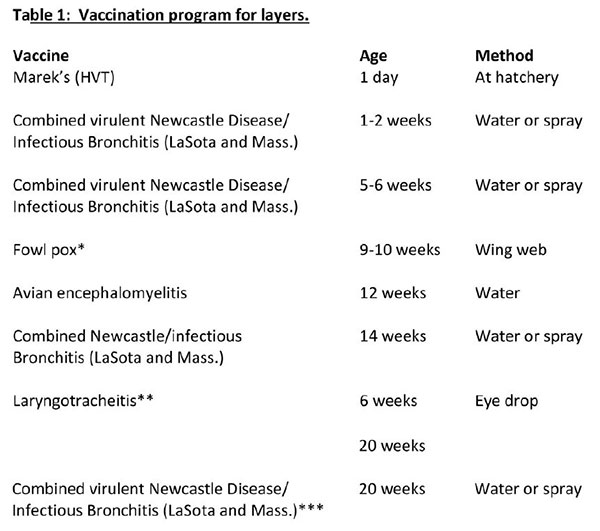by Howard Enos, Douglas Kuney, Carey Quarles, Charles Whiteman and William Brown* (12/19)
Quick Facts…
- Before vaccinating poultry, the disease and flock vaccination history should be known.
- Only flocks in good health should be vaccinated.
- Vaccines are living, disease-causing organisms, and they should be treated with respect.
- Outdated vaccines should never be used.
- Correct dosages should be given to birds; doses should not be stretched.
- Vaccines should be kept cool, away from sunlight and direct heat, and stored according to manufacturer’s directions.
- Good sanitation is the key to all disease prevention programs.
This fact sheet was written to serve as a helpful guideline for flock owners as they work to prevent poultry disease and to help develop a biosecurity plan.
All day-old chickens should be vaccinated at the hatchery for Marek’s disease. Young chickens should be vaccinated with virulent Newcastle Disease and infectious bronchitis vaccines early in their life. These should be followed by a program of repeated vaccinations against these two diseases during the egg production period. Either the B1 Hitchner strain of virulent Newcastle Disease vaccine or the B1 La Sota strain may be used.
Vaccines for the protective control of other diseases of chickens also are discussed in this fact sheet (For more information on ailments of chickens, see Fact Sheet 2.505).
Successful Vaccination Procedure
A vaccination program suited to an individual farm or ranch should be developed. Before vaccinating poultry, the flock disease and vaccination history should be known. That information can be retrieved from the breeder. If unvaccinated birds are preferred, contact the hatchery prior to purchase and shipment of the birds. Only flocks in good health should be vaccinated and vaccinations should not be administered during periods of stress such as transportation.
Personnel Selection
A person who is well trained in administering vaccine techniques and methods should be selected to give all vaccinations. This person should be up to date on all disease outbreaks within the state and should be aware of all new vaccines available and of any changes in routes of vaccine administration. Develop a veterinarian client patient relationship (VCPR) with your local veterinarian.
Care of Vaccines
Most vaccines are living, disease-causing organisms, and they should be handled with care and treated with respect. All vaccines should be kept cool and out of the sun, following the manufacturer’s recommendations for storage.
An inventory of all vaccines should be kept current; the oldest supply should be used first, and outdated vaccines should never be used. After the vaccines are used, all leftover vaccine containers should be disposed of by incineration or dropped off at a veterinarians’ office for proper disposal. Disinfectants (sanitizers) in water destroy living vaccines (See section on preparation and administration of vaccines for more details).
Vaccination Records
Complete records of vaccination programs should be kept at all times. The records should contain the following information:
- Identification for flock receiving vaccination: e.g. flock number, farm
number and building number. - Name and/or type of vaccine and method of administration.
- Serial number of the vaccine.
- Expiration date of the vaccine.
- Manufacturer of the vaccine.
- Date the vaccine was given.
- Name of person giving the vaccine.
- Method, temperature and where the vaccine was stored.
Preparation and Administration of Vaccines
The person giving the vaccinations should:
- Be sure vaccine is not outdated;
- Store and administer all vaccines according to manufacturer’s recommendations;
- Withhold sanitizers from drinking water three days prior to administrating vaccine by water;
- Wash all water containers with a brush and clean hot water (not sanitizers or soaps) 24 hours prior to vaccination;
- Remove drinking water one hour prior to giving vaccine by the water method (if birds are in production, 30 minutes should be allowed);
- Give vaccines within 30 minutes of the time they are prepared;
- Make sure that correct dosages are administered to birds (doses should not be stretched);
- Keep vaccines away from children, sunlight and direct heat;
In preparation of water-type virus vaccines, salmonella-free, powdered skim milk should be added to the vaccine. The milk proteins neutralize small amounts of sanitizer that may be present in the water. Use distilled water for mixing.
Three ounces (85 grams) of powdered skim milk should be mixed with ten gallons (38 liters) of clean distilled water. The vaccine should be premixed as directed. The premixed vaccine then can be combined thoroughly with the premixed skim milk and distilled water. A person then should administer the vaccine immediately, taking all precautions as directed by the manufacturer (i.e. wearing face mask, latex gloves, etc.)
Vaccinating is one of many methods that can be used to help prevent disease, but good sanitation practices by all personnel is the one key practice that must be used in all disease prevention programs.

*Fowl pox vaccine need not be given unless it has been administered in the past or if there has been an outbreak in the area.
**Laryngotracheitis vaccine should not be given unless there has been a history of the disease on the premises or unless there is an outbreak in the area.
***Starting at 20 weeks of age and continuing through the lay cycle, all birds must be vaccinated with virulent Newcastle Disease/Infectious Bronchitis vaccine every 10 weeks.





